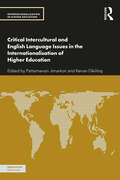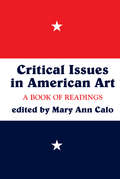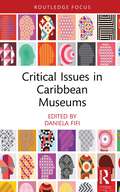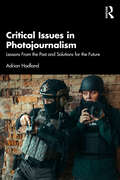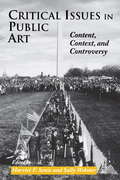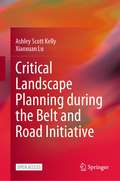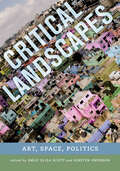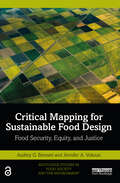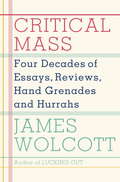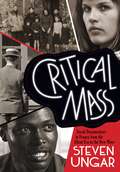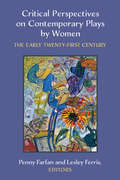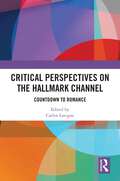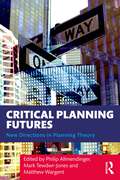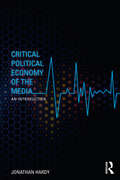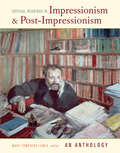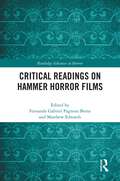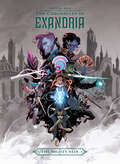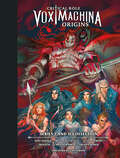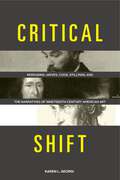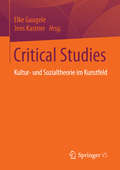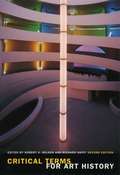- Table View
- List View
Critical Intercultural and English Language Issues in the Internationalisation of Higher Education (Internationalization in Higher Education Series)
by Kenan Dikilitaş Pattamawan JimarkonInternationalisation is key to a modern and diverse higher education. Closely related to this is the successful integration of different cultures and languages. This book explores the dynamic relationships between English as a Lingua Franca (ELF), intercultural communication competence (ICC), internationalisation, and the use of the English language in international higher education.Featuring contributions from authors from Türkiye, Slovenia, Thailand, Taiwan and Norway, the chapters discuss topics such as translanguaging, language-related policies in internationalisation, issues of language and interculturality from a contextual point of view of pedagogy, and provide critical reflections on perceptions and orientations in support of higher education internationalisation. Ultimately, the book provides a comprehensive understanding of how the English language functions as a tool for intercultural engagement in academic settings, and the ways in which it is encountered and perceived by researchers, leaders, and practitioners.This book will be valuable reading for applied linguists, teacher educators and researchers, and graduate students in higher education involved in internationalised higher education through teaching, projects and activities.
Critical Issues In American Art: A Book Of Readings
by Mary Ann CaloThis anthology of essays on different critical approaches and methodologies for the analysis and interpretation of American art and artists is designed for students and teachers in American art history and American studies programs. It contains twenty selections from academic journals on American art from colonial times to 1940. Mary Ann Calo provides an introduction to the anthology, explaining its purpose and organization, and each selection has a brief introduction about its main focus and scholarly approach. These case studies show the diversity of scholarly thinking about interpreting American works of art, which should be useful for teachers and comprehensible and interesting for students.This anthology contains twenty articles on American art from colonial times to 1940. The selections are mainly from academic journals and aim to provide the student and teacher with different critical approaches and methodologies for the analysis and interpretation of American art and artists. Mary Ann Calo's preface to the anthology explains its purpose and organization, and each article will have a brief introduction about its main focus and scholarly approach.This text meets the need in American art history studies for an anthology of essays on critical approaches and methodologies.
Critical Issues in Caribbean Museums
by Daniela FifiCritical Issues in Caribbean Museums examines the challenges faced within the field of Caribbean Museology. Museums are sites of heritage management and, within Caribbean contexts, essential spaces for the examination of postcolonial relationships to past disenfranchisement.This book helps to identify strategies within museology that can inspire meaningful collective engagement with these histories. In the process, it also identifies the hurdles museums in the Caribbean face when telling stories of ancestral oppression. Each chapter presents a new case study, written by five museum professionals and scholars fundamentally shaping conversations on cultural heritage spaces within the Caribbean and the diaspora of Caribbean nations. Using their observations this book coalesces an understanding of the specific limitations Caribbean cultural heritage spaces face and deploys new strategies for maximising their engagement potential.Critical Issues in Caribbean Museums is written for Museum Studies researchers and museum practitioners, especially those actively engaged in the process of preserving Caribbean cultural heritage, advancing museum development in the Caribbean or in other nations for future generations.
Critical Issues in Photojournalism: Lessons From the Past and Solutions for the Future
by Adrian HadlandDrawing on original research and industry experience, this book studies the historical debates and controversies underpinning photojournalism and those practising it today.Beginning with the origins of photography and the close-knit relationship between journalism and the image, this book goes on to consider the theories that have sought to unpick photography and photojournalism and how these translate to contemporary practice. Hadland examines the present and potential roles of photojournalism in society and reflects on how technological advances such as Artificial Intelligence may impact the profession. Ethical considerations and certain immeasurable dimensions of photography, including concepts of power, truth, and meaning, are brought into question alongside ongoing issues of exclusion and homogeneity amongst professional photojournalists.Critical Issues in Photojournalism is an ideal primer for students seeking a solid historical, ethical, and reflective understanding of the discipline.
Critical Issues in Public Art
by Harriet SenieIn this groundbreaking anthology, twenty-two artists, architects, historians, critics, curators, and philosophers explore the role of public art in creating a national identity, contending that each work can only be understood by analyzing the context in which it is commissioned, built, and received. They emphasize the historical continuum between traditional works such as Mount Rushmore, the Washington Monument, and the New York Public Library lions, in addition to contemporary memorials such as the Vietnam Veterans Memorial and the Names Project AIDS Quilt. They discuss the influence of patronage on form and content, isolate the factors that precipitate controversy, and show how public art overtly and covertly conveys civic values and national culture.Complete with an updated introduction, Critical Issues in Public Art shows how monuments, murals, memorials, and sculptures in public places are complex cultural achievements that must speak to increasingly diverse groups.
Critical Landscape Planning during the Belt and Road Initiative
by Ashley Scott Kelly Xiaoxuan LuThis open access book traces the development of landscapes along the 414-kilometer China–Laos Railway, one of the first infrastructure projects implemented under China’s Belt and Road Initiative (BRI) and which is due for completion at the end of 2021. Written from the perspective of landscape architecture and intended for planners and related professionals engaged in the development and conservation of these landscapes, this book provides history, planning pedagogy and interdisciplinary framing for working alongside the often-opaque planning, design and implementation processes of large-scale infrastructure. It complicates simplistic notions of development and urbanization frequently reproduced in the Laos–China frontier region. Many of the projects and sites investigated in this book are recent “firsts” in Laos: Laos’s first wildlife sanctuary for trafficked endangered species, its first botanical garden and its first planting plan for a community forest. Most often the agents and accomplices of neoliberal development, the planning and design professions, including landscape architecture, have little dialogue with either the mainstream natural sciences or critical social sciences that form the discourse of projects in Laos and comparable contexts. Covering diverse conceptions and issues of development, including cultural and scientific knowledge exchanges between Laos and China, nature tourism, connectivity and new town planning, this book also features nine planning proposals for Laos generated through this research initiative since the railway's groundbreaking in 2016. Each proposal promotes a wider "landscape approach" to development and deploys landscape architecture’s spatial and ecological acumen to synthesize critical development studies with the planner's capacity, if not naive predilection, to intervene on the ground. Ultimately, this book advocates the cautious engagement of the professionally oriented built-environment disciplines, such as regional planning, civil engineering and landscape architecture, with the landscapes of development institutions and environmental NGOs.
Critical Landscapes: Art, Space, Politics
by Emily Eliza Scott and Kirsten SwensonFrom Francis Alÿs and Ursula Biemann to Vivan Sundaram, Allora & Calzadilla, and the Center for Urban Pedagogy, some of the most compelling artists today are engaging with the politics of land use, including the growth of the global economy, climate change, sustainability, Occupy movements, and the privatization of public space. Their work pivots around a set of evolving questions: In what ways is land, formed over the course of geological time, also contemporary and formed by the conditions of the present? How might art contribute to the expansion of spatial and environmental justice? Editors Emily Eliza Scott and Kirsten Swenson bring together a range of international voices and artworks to illuminate this critical mass of practices. One of the first comprehensive treatments of land use in contemporary art, Critical Landscapes skillfully surveys the stakes and concerns of recent land-based practices, outlining the art historical contexts, methodological strategies, and geopolitical phenomena. This cross-disciplinary collection is destined to be an essential reference not only within the fields of art and art history, but also across those of cultural geography, architecture and urban planning, environmental history, and landscape studies.
Critical Mapping for Sustainable Food Design: Food Security, Equity, and Justice (Routledge Studies in Food, Society and the Environment)
by Audrey G. Bennett Jennifer A. VokounThis book introduces critical mapping as a problematizing, reflective approach for analyzing systemic societal problems like food, scoping out existing solutions, and finding opportunities for sustainable design intervention. This book puts forth a framework entitled "wicked solutions" that can be applied to determine issues that designers should address to make real differences in the world and yield sustainable change. The book assesses the current role of design in attaining food security in a sustainable, equitable, and just manner. Accomplishing this goal is not simple; if it was, it would not be called a wicked problem. But this book shows how a particular repertoire of design tools can be deployed to find solutions and strategize the development of novel outcomes within a complex and interconnected terrain. To address the wicked problem of food insecurity, inequity, and injustice, this book highlights 73 peer-reviewed design outcomes that epitomize sustainable food design. This includes local and regional sustainable design outcomes funded or supported by public or private institutions and local and widespread design outcomes created by citizens. In doing so, this book sets the stage for an evidence-driven and evidence-informed design future that facilitates the designers’ visualization of wicked solutions to complex social problems, such as food insecurity. Drawing on an array of case studies from across the world, from urban rooftop farms and community cookers to mobile apps and food design cards, this book provides vitally important information about existing sustainable food design outcomes in a way that is organized, accessible, and informative. This book will be of great interest to academics and professionals working in the field of design and sustainable food systems. Students interested in learning about food and sustainability from across design studies, food studies, innovation and entrepreneurship, urban studies, and global development will also find this book of great use.
Critical Mapping for Sustainable Food Design: Food Security, Equity, and Justice (Routledge Studies in Food, Society and the Environment)
by Audrey G. Bennett Jennifer A. VokounThis book introduces critical mapping as a problematizing, reflective approach for analyzing systemic societal problems like food, scoping out existing solutions, and finding opportunities for sustainable design intervention.This book puts forth a framework entitled "wicked solutions" that can be applied to determine issues that designers should address to make real differences in the world and yield sustainable change. The book assesses the current role of design in attaining food security in a sustainable, equitable, and just manner. Accomplishing this goal is not simple; if it was, it would not be called a wicked problem. But this book shows how a particular repertoire of design tools can be deployed to find solutions and strategize the development of novel outcomes within a complex and interconnected terrain. To address the wicked problem of food insecurity, inequity, and injustice, this book highlights 73 peer-reviewed design outcomes that epitomize sustainable food design. This includes local and regional sustainable design outcomes funded or supported by public or private institutions and local and widespread design outcomes created by citizens. In doing so, this book sets the stage for an evidence-driven and evidence-informed design future that facilitates the designers’ visualization of wicked solutions to complex social problems, such as food insecurity. Drawing on an array of case studies from across the world, from urban rooftop farms and community cookers to mobile apps and food design cards, this book provides vitally important information about existing sustainable food design outcomes in a way that is organized, accessible, and informative.This book will be of great interest to academics and professionals working in the field of design and sustainable food systems. Students interested in learning about food and sustainability from across design studies, food studies, innovation and entrepreneurship, urban studies, and global development will also find this book of great use.
Critical Mass
by James WolcottA career-spanning collection of critical essays and cultural journalism from one of the most acute, entertaining, and sometimes acerbic (but in a good way) critics of our timeFrom his early-seventies dispatches as a fledgling critic for The Village Voice on rock 'n' roll, comedy, movies, and television to the literary criticism of the eighties and nineties that made him both feared and famous to his must-read reports on the cultural weather for Vanity Fair, James Wolcott has had a career as a freelance critic and a literary intellectual nearly unique in our time. This collection features the best of Wolcott in whatever guise--connoisseur, intrepid reporter, memoirist, and necessary naysayer--he has chosen to take on. Included in this collection is "O.K. Corral Revisited," a fresh take on the famed Norman Mailer-Gore Vidal dustup on The Dick Cavett Show that launched Wolcott from his Maryland college to New York City (via bus) to begin his brilliant career. His prescient review of Patti Smith's legendary first gig at CBGB leads off a suite of eyewitness and insider accounts of the rise of punk rock, while another set of pieces considers the vast cultural influence of the enigmatic Johnny Carson and the scramble of his late-night successors to inherit the "swivel throne." There are warm tributes to such diverse figures as Michael Mann, Sam Peckinpah, Lester Bangs, and Philip Larkin and masterly summings-up of the departed giants of American literature--John Updike, William Styron, John Cheever, and Mailer and Vidal. Included as well are some legendary takedowns that have entered into the literary lore of our time. Critical Mass is a treasure trove of sparkling, spiky prose and a fascinating portrait of our lives and cultural times over the past decades. In an age where a great deal of back scratching and softball pitching pass for criticism, James Wolcott's fearless essays and reviews offer a bracing taste of the real critical thing.
Critical Mass: Social Documentary in France from the Silent Era to the New Wave
by Steven UngarThirty-five years of nonfiction films offer a unique lens on twentieth-century French social issuesCritical Mass is the first sustained study to trace the origins of social documentary filmmaking in France back to the late 1920s. Steven Ungar argues that socially engaged nonfiction cinema produced in France between 1945 and 1963 can be seen as a delayed response to what filmmaker Jean Vigo referred to in 1930 as a social cinema whose documented point of view would open the eyes of spectators to provocative subjects of the moment.Ungar identifies Vigo&’s manifesto, his 1930 short À propos de Nice, and late silent-era films by Georges Lacombe, Boris Kaufman, André Sauvage, and Marcel Carné as antecedents of postwar documentaries by Eli Lotar, René Vautier, Alain Resnais, Chris Marker, and Jean Rouch, associated with critiques of colonialism and modernization in Fourth and early Fifth Republic France. Close readings of individual films alternate with transitions to address transnational practices as well as state- and industry-wide reforms between 1935 and 1960. Critical Mass is an indispensable complement to studies of nonfiction film in France, from Georges Lacombe&’s La Zone (1928) to Chris Marker&’s Le Joli Mai (1963).
Critical Perspectives on Applied Theatre
by Helen Nicholson Hughes, Jenny and Nicholson, Helen Jenny HughesAs the twenty-first century moves towards its third decade, applied theatre is being shaped by contemporary economic and environmental concerns and is contributing to new conceptual paradigms that influence the ways in which socially engaged art is produced and understood. This collection offers fresh perspectives on the aesthetics, politics and histories of applied theatre. With contributions from leading scholars in the field, the book illuminates theatre in a diverse range of global contexts and regions. Divided into three sections - histories and cultural memories; place, community and environment; and poetics and participation - the chapters interweave cutting-edge theoretical insights with examples of innovative creative practice that traverse different places, spaces and times. Essential reading for researchers and artists working within applied theatre, this collection will also be of interest to those in theatre and performance studies, education, cultural policy, social history and cultural geography.
Critical Perspectives on Contemporary Plays by Women: The Early Twenty-First Century
by Lesley Ferris Penny FarfanThis book foregrounds some of the ways in which women playwrights from across a range of contexts and working in a variety of forms and styles are illuminating the contemporary world while also contributing to its reshaping as they reflect, rethink, and reimagine it through their work for the stage. The book is framed by a substantial introduction that sets forth the critical vision and structure of the book as a whole, and an afterword that points toward emerging currents in and expansions of the contemporary field of playwriting by women on the cusp of the third decade of the twenty-first century. Within this frame, the twenty-eight chapters that form the main body of the book, each focusing on a single play of critical significance, together constitute a multifaceted, inevitably partial, yet nonetheless integral picture of the work of women playwrights since 2000 as they engage with some of the most pressing issues of our time. Some of these issues include the continuing oppression of and violence against women, people of color, LGBTQ+ people, and ethnic minorities; the ongoing processes of decolonization; the consequences of neoliberal capitalism; the devastation and enduring trauma of war; global migration and the refugee crisis; the turn to right-wing populism; and the impact of climate change, including environmental disaster and species extinction. The book is structured into seven sections: Replaying the Canon; Representing Histories; Staging Lives; Re-imagining Family; Navigating Communities; Articulating Intersections; and New World Order(s). These sections group clusters of plays according to the broad critical actions they perform or, in the case of the final section, the new world orders that they capture through their stagings of the seeming impasse of the politically and environmentally catastrophic global present moment. There are many other points of resonance among and across the plays, but this seven-part structure foregrounds the broader actions that drive the plays, both in the Aristotelian dramaturgical sense and in the larger sense of the critical interventions that the plays creatively enact. In this way, the seven-part structure establishes correspondences across the great diversity of dramatic material represented in the book while at the same time identifying key methods of critical approach and areas of focus that align the book’s contributors across this diversity. The structure of the book thus parallels what the playwrights themselves are doing, but also how the contributors are approaching their work. Plays featured in the book are from Canada, Australia, South Africa, the US, the UK, France, Argentina, New Zealand, Syria, Brazil, Italy, and Austria; the playwrights include Margaret Atwood, Leah Purcell, Yaël Farber, Paula Vogel, Adrienne Kennedy, Suzan-Lori Parks, debbie tucker green, Lisa Loomer, Hélène Cixous, Anna Deavere Smith, Lola Arias, Lisa Kron and Jeanine Tesori, Marie Clements, Quiara Alegría Hudes, Alia Bano, Holly Hughes, Whiti Hereaka, Julia Cho, Liwaa Yazji, Grace Passô, Dominique Morisseau, Emma Dante, Frances Ya-Chu Cowhig, Lynn Nottage, Elfriede Jelinek, Caryl Churchill, Colleen Murphy, and Lucy Kirkwood. Encompassing several generations of playwrights and scholars, ranging from the most senior to mid-career to emerging voices, the book will be essential reading for established researchers, a valuable learning resource for students at all levels, and a useful and accessible guide for theater practitioners and interested theater-goers.
Critical Perspectives on the Hallmark Channel: Countdown to Romance
by Carlen LavigneThis multinational, multidisciplinary collection of essays focuses on Hallmark Channel movies and Hallmark’s position in the changing North American media landscape.This book covers the ‘Countdown to Christmas’ offerings, year-round productions, made-for-TV mysteries and romances, Hallmark’s use of specific filming locations, and its relationship to viewer desires. Chapters examine Hallmark’s position in a changing sociopolitical context and the tensions the company must navigate in creating more “progressive” content; they discuss issues of gender, race, sexuality, and place, as well as analyzing the extensive ranges and reactions of social media participants and interrogating the nature of Hallmark’s popularity.Suitable for scholars and students of film and tv and popular culture studies, this is a multifaceted look at both Hallmark and its viewers at a particular moment of Hallmark’s market dominance.
Critical Planning Futures: New Directions in Planning Theory
by Philip Allmendinger Mark Tewdwr-Jones Matthew WargentPlanning lies at the heart of successful and sustainable places, yet planning scholarship often appears stuck in routinised patterns of thought. Critical Planning Futures brings together an international range of voices from diverse disciplinary backgrounds to explore new directions in planning theory, interrogate planning’s orthodoxy, and push the boundaries of contemporary theory using ideas both from within planning and beyond. Contributors draw on examples from across the globe, considering the applicability of concepts and theories across traditional divides. In this way, Critical Planning Futures continues planning’s rich tradition of borrowing ideas from elsewhere and using those ideas to shine a light back onto well-rehearsed theoretical debates to set out new ways forward for planning in the twenty-first century. This book will be a vital resource for planning specialists, though the breadth of ideas will be of interest to academics and researchers in a wide range of disciplines, including urban studies, geography, political science, and sociology.
Critical Political Economy of the Media: An Introduction (Communication and Society)
by Jonathan HardyHow the media are organised and funded is central to understanding their role in society. Critical Political Economy of the Media provides a clear, comprehensive and insightful introduction to the political economic analysis of contemporary media. Jonathan Hardy undertakes a critical survey of political economy scholarship encompassing worldwide literature, issues and debates, and relationships with other academic approaches. He assesses different ways of making sense of media convergence and digitalisation, media power and influence, and transformations across communication markets. Many of the problems of the media that prompted critical political economy research remain salient, he argues, but the approach must continue to adapt to new conditions and challenges. Hardy advances the case for a revitalised critical media studies for the 21st century. Topics covered include: media ownership and financing news and entertainment convergence and the Internet media globalisation advertising and media alternative media media policy and regulation Introducing key concepts and research, this book explains how political economy can assist students, researchers and citizens to investigate and address vital questions about the media today.
Critical Readings in Impressionism and Post-Impressionism: An Anthology
by Mary Tompkins LewisThe essays in this wide-ranging, beautifully illustrated volume capture the theoretical range and scholarly rigor of recent criticism that has fundamentally transformed the study of French Impressionist and Post-Impressionist art. Readers are invited to consider the profound issues and penetrating questions that lie beneath this perennially popular body of work as the contributors examine the art world of late nineteenth-century France—including detailed looks at Monet, Manet, Pissarro, Degas, Cézanne, Morisot, Seurat, Van Gogh, and Gauguin. The authors offer fascinating new perspectives, placing the artworks from this period in wider social and historical contexts. They explore these painters' pictorial and market strategies, the critical reception and modern criteria the paintings engendered, and the movement's historic role in the formation of an avant-garde tradition. Their research reflects the wealth of new documents, critical approaches, and scholarly exhibitions that have fundamentally altered our understanding of Impressionism and Post-Impressionism. These essays, several of which have previously been familiar only to scholars, provide instructive models of in-depth critical analysis and of the competing art historical methods that have crucially reshaped the field. Contributors: Carol Armstrong, T. J. Clark, Stephen F. Eisenman, Tamar Garb, Nicholas Green, Robert L. Herbert, John House, Mary Tompkins Lewis, Michel Melot, Linda Nochlin, Richard Shiff, Debora Silverman, Paul Tucker, Martha Ward
Critical Readings on Hammer Horror Films (Routledge Advances in Horror)
by Fernando Gabriel Pagnoni Berns Matthew EdwardsThis collection offers close readings on Hammer’s cycle of horror films, analysing key films and placing particular emphasis on the narratives and themes present in the works discussed.Ranging from the studio’s first horror outing, The Mystery of the Mary Celeste (1935) to Hammer’s last contemporary film, Doctor Jekyll (2023), the collection celebrates cult-favourites such as The Quatermass Experiment, the films of Terence Fisher, to overlooked classics such as Captain Clegg or The Mummy franchise. This volume also delves into Hammer’s psychological thrillers, the studio’s venture into TV with Hammer’s House of Horrors, with theoretical frameworks varying from queer studies to postcolonial readings.This volume will appeal to scholars and students of film studies, international cinema, film history and horror studies.
Critical Role: The Chronicles of Exandria The Mighty Nein
by Critical RoleThis art collection features a wide variety of gorgeous illustrations from the Critical Role fan community paired with text by cast members.Journey through Wildemount alongside the motley group known as the Mighty Nein! Encompassing the first chapters of Critical Role's second campaign, this tome illustrates the adventures of our unlikely heroes as they meet in Trostenwald, struggle through a heartbreaking encounter with the Iron Shepherds, and more. Featuring stunning works by artists from the Critter community, Critical Role: The Chronicles of Exandria -- The Mighty Nein is a beautiful way to revisit the origin of the Mighty Nein through the perspective of Expositor Beauregard Lionett and the archivists of the Cobalt Soul.
Critical Role: Vox Machina Origins Library Edition: Series I & II Collection
by Critical Role Jody Houser Matthew ColvilleThe celebrated series Critical Role: Vox Machina Origins returns! Fans of the series won't want to miss this beautiful collection.What do a flirtatious bard, a clueless barbarian, a naïve druid, and a pair of stealthy twins all have in common? They're not sure either, but one day they'll become the heroes known as Vox Machina! Follow the main characters from the smash-hit series Critical Role as they team up for the first time, facing cults and curses in the revelation of their origins and the path that will lead them to glory...eventually.Collects Vox Machina Origins I and II with never before seen artwork!
Critical Shift: Rereading Jarves, Cook, Stillman, and the Narratives of Nineteenth-Century American Art
by Karen L. GeorgiAmerican Civil War–era art critics James Jackson Jarves, Clarence Cook, and William J. Stillman classified styles and defined art in terms that have become fundamental to our modern periodization of the art of the nineteenth century. In Critical Shift, Karen Georgi rereads many of their well-known texts, finding certain key discrepancies between their words and our historiography that point to unrecognized narrative desires. The book also studies ruptures and revolutionary breaks between “old” and “new” art, as well as the issue of the morality of “true” art. Georgi asserts that these concepts and their sometimes loaded expression were part of larger rhetorical structures that gainsay the uses to which the key terms have been put in modern historiography.It has been more than fifty years since a book has been devoted to analyzing the careers of these three critics, and never before has their role in the historiography and periodization of American art been analyzed. The conclusions drawn from this close rereading of well-known texts challenge the fundamental nature of “historical context” in American art history.
Critical Shift: Rereading Jarves, Cook, Stillman, and the Narratives of Nineteenth-Century American Art
by Karen L. GeorgiAmerican Civil War–era art critics James Jackson Jarves, Clarence Cook, and William J. Stillman classified styles and defined art in terms that have become fundamental to our modern periodization of the art of the nineteenth century. In Critical Shift, Karen Georgi rereads many of their well-known texts, finding certain key discrepancies between their words and our historiography that point to unrecognized narrative desires. The book also studies ruptures and revolutionary breaks between “old” and “new” art, as well as the issue of the morality of “true” art. Georgi asserts that these concepts and their sometimes loaded expression were part of larger rhetorical structures that gainsay the uses to which the key terms have been put in modern historiography.It has been more than fifty years since a book has been devoted to analyzing the careers of these three critics, and never before has their role in the historiography and periodization of American art been analyzed. The conclusions drawn from this close rereading of well-known texts challenge the fundamental nature of “historical context” in American art history.
Critical Studies: Kultur- und Sozialtheorie im Kunstfeld
by Elke Gaugele Jens KastnerDer Einführungsband zu Kultur- und Sozialtheorien im Kunstfeld bildet den ,State of the Art' gegenwärtiger Kunstausbildung in seiner transdisziplinären und methodologischen Vielfalt ab. Die disziplinäre Palette reicht dabei von traditionsreichen Fächern wie Philosophie und Kunstgeschichte über Kultur- und Kunstsoziologie, Architektur- und Medientheorie, bis hin zu den Studies der Gegenwart: Queer Studies, Visual Studies, Transcultural Studies, Fashion Studies u. a. Darüber hinaus werden fächerübergreifende theoretische Ansätze und angewandte Praxisfelder vorgestellt.
Critical Terms for Art History (2nd edition)
by Robert S. Nelson Richard Shiff"Art" has always been contested terrain, whether the object in question is a medieval tapestry or Duchamp's Fountain.
Critical Terms for Art History, Second Edition (Critical Terms Ser.)
by Nelson, Robert S.; Shiff, Richard"Art" has always been contested terrain, whether the object in question is a medieval tapestry or Duchamp's Fountain. But questions about the categories of "art" and "art history" acquired increased urgency during the 1970s, when new developments in critical theory and other intellectual projects dramatically transformed the discipline. The first edition of Critical Terms for Art History both mapped and contributed to those transformations, offering a spirited reassessment of the field's methods and terminology. Art history as a field has kept pace with debates over globalization and other social and political issues in recent years, making a second edition of this book not just timely, but crucial. Like its predecessor, this new edition consists of essays that cover a wide variety of "loaded" terms in the history of art, from sign to meaning, ritual to commodity. Each essay explains and comments on a single term, discussing the issues the term raises and putting the term into practice as an interpretive framework for a specific work of art. For example, Richard Shiff discusses "Originality" in Vija Celmins's To Fix the Image in Memory, a work made of eleven pairs of stones, each consisting of one "original" stone and one painted bronze replica. In addition to the twenty-two original essays, this edition includes nine new ones—performance, style, memory/monument, body, beauty, ugliness, identity, visual culture/visual studies, and social history of art—as well as new introductory material. All help expand the book's scope while retaining its central goal of stimulating discussion of theoretical issues in art history and making that discussion accessible to both beginning students and senior scholars. Contributors: Mark Antliff, Nina Athanassoglou-Kallmyer, Stephen Bann, Homi K. Bhabha, Suzanne Preston Blier, Michael Camille, David Carrier, Craig Clunas, Whitney Davis, Jas Elsner, Ivan Gaskell, Ann Gibson, Charles Harrison, James D. Herbert, Amelia Jones, Wolfgang Kemp, Joseph Leo Koerner, Patricia Leighten, Paul Mattick Jr., Richard Meyer, W. J. T. Mitchell, Robert S. Nelson, Margaret Olin, William Pietz, Alex Potts, Donald Preziosi, Lisbet Rausing, Richard Shiff, Terry Smith, Kristine Stiles, David Summers, Paul Wood, James E. Young
